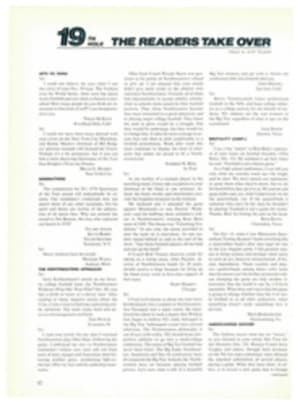
9,000 hp and plush by the ton
Turn a sailing man loose at a show devoted largely to powerboats and what do you get? You get a sailorman whose appreciation for recent advances in hull design is tempered by an old-time suspicion that power corrupts. It has ever been thus between sailors and power-boaters; a sailor comes away from an exhibit like the recent Dinner Key show in Miami convinced that powerboating is headed for the bedroom by way of the Indianapolis Speedway. In powerboats, horsepower and sexy interiors seem to be the order of the day.
Listen to what Johnson, a producer of dependable outboard power for more than half a century, has to say about speed. The company introduces its 1979 "top-of-the-line" V-6 outboards (150 to 235 horsepower) with the following pitches: "They have the get-up-and-go to pop a large hull up on plane, then throttle back to a fuel-efficient—yet movin' out—cruising speed. With enough power left 'in the hole' for a fast run back to the harbor to beat the sunset."
Such a sales pitch might not be altogether misdirected. A large portion of the boat-buying public seems to consist of speed-oriented folks who would have no fun at sea unless they took the fast tempo of the land with them. Beating the sunset home is a natural rhythm in the lives of such people, and there is no ridding them of it. While tending my own modest Johnson motor on a Connecticut dock two summers ago, I heard the head of an outbound boating party bellowing to his straggling entourage, "Let's get all this junk on the boat. It's awready 12:30. Let's get out there and have a good time and get it over with."
Despite the ever-quickening tempo, however, there are still those who go to sea seeking an easier pace.
At Dinner Key, where the hulls of more than 80 manufacturers were displayed, among the thousands who clambered aboard the boats was one potential buyer, a local chiropractor named Bill Pfenninger, who epitomizes what the sport used to be. From 1966 through 1973, Pfenninger owned a 26-foot lap-strake Lyman Cruisette, and at the Miami show he was hunting for the sort of practical, trailerable small cruiser that might take the place of his old Lyman. Beating the sunset home has never been an obsession with Pfenninger. A while back he and a friend set out for a day sail in a 22-foot Pearson sloop. The weather was so good they decided to extend the trip just a bit. The following day was so fair they decided to sail on. They sailed on and on and on, all the way to Key West. They got back home 21 sunsets later than they had originally planned.
Ten years ago more than 150 manufacturers produced powerboats in the 18-to-26-foot range. Today there are only about 90, and not all of these are survivors of the original 150. In the welter of small cruisers now being offered with an eight-foot beam so they may be trailered without special permit, there is variety enough to satisfy both speed demons and sensible seamen—and more than enough to confuse novices who are not sure what they want. Most of the hulls offered have a traditional Vee shape with fore and aft straking to cushion the ride. In some the sharp Vee forward is carried excessively aft, which is fine for an ocean racer or even when one of these vessels is charging along at 25 knots or better, but at a slower pace the bow rides absurdly high, especially for cruising comfort.
A great many of the small cruisers today have extreme reverse sheer forward—a drooping of the bow so pronounced that the hull appears to have melted slightly after being popped from the mold. This droopy, nose-down look, which in profile resembles the snout of Snoopy, is effected, salesmen maintain, to give the boats an aura of super speed. Such contrived esthetics may sell tyros in the showroom, but will scarcely impress anyone who has to go forward onto such a sloping deck on a bouncy day to get an anchor up or down.
Twenty years ago, small cruisers that reputedly would sleep four were common and provoked a long-standing joke. Such boats, it was said, could sleep four romantically, three obscenely, but only two comfortably. The builders of small cruisers are less pretentious today. Few of them make any claim that their 24-or 25-footers, when cruising, can accommodate more than two adults and a couple of kids. The Vee-berths forward, which in older boats were often too short for ordinary men, are now almost adequate for basketball players.
Although present designers have been sensible in utilizing interior space for berths and galley and head, in superficial appointments some have gone ape. Do you have shag carpeting on the ceiling of your bedroom? Or on your closet shelves? Do you have tufted cushions that soak up water in a heavy rain on your front porch? That is the sort of impractical luxury one finds on many small cruisers today. Why? Salesmen say it's what the public wants.
If they want it, they should have it. But to complement all of the superficial luxuries and jazzy appointments, there should be proper equipment for such routine procedures as anchoring, mooring and docking.
For example, the shopper should ask the salesmen if it is possible to put spring-line cleats near the point of maximum beam. If you explain what you mean by maximum beam, some of them will say yes. Some of them don't know what a spring line is. Ask a salesman why a sassy-looking cruiser has an outboard handrail leading from the cabin forward, but not an inch of foothold around the cabin. He will explain that the handrail is simply for "cosmetic appearances." If pressed on the matter, the salesman may further add that the U.S. Coast Guard recommends that the only access forward on small cruisers should be through a forward hatch. Check the Coast Guard on it, and they will tell you they have never made such an absurd recommendation.
Stamas, a Florida company that produces sensible boats with non-skid walk-around decking and forward hatch, says this about some of the less sensible products of its rivals: "In many cruisers today the bow area is reached at the crawler's own risk."
Examine the forward hatches of half a dozen boats. You will probably find all of them suitable for seagoing orangutans, but the chances are some of them will be too small for an average-sized man who is trying to hustle forward in an all-hands emergency. Examine one of the flashier cruisers now on the market and you will find there is no point to fix a line on the foredeck except one cleat on each side five feet back of the stem and three feet off the centerline. If anchored from such a point in a one-foot sea and 10 knots of wind, the boat would wander restlessly on its rode. If towed from such a cleat in even a modest sea, it would wallow back and forth like a drunken old sow.
Reviewing the trend in modern boats, Gary Ross, the marketing director of the Tiara Division of S-2 Yachts, Inc., says, "The marine industry is a strange business. It is not large, but it is very visible. The sea hasn't changed in a million years, but in the last 15 years the marketing of boats has changed drastically. Marketing now ignores the possibility that someone might want to go offshore in a boat that is sensible and practical and come back safely like a Boothbay lobsterman. Too many people who are buying boats are looking for a duplicate of their living room. Their idea of roughing it is to spend a night in a Holiday Inn without color TV. To sell them a boat you have to have unborn yak hair overhead in the cabin and all sorts of monkey fuzz in the cockpit, and you must have about 9,000 horsepower. The first question some prospective buyers ask is, 'How fast will it go?' Then when they get the boat, they go through propellers the way you go through socks."
There is only one trouble with Ross' summary: none of the absurdities he cites as "musts" in a successful boat are in the boats he is successfully selling. The 25-foot Sport Salon, the top of the Tiara line, is both sensible and practical. It's the sort of craft anyone more interested in pleasure than puffery might enjoy. Its flying bridge is only 39 inches above the cockpit, yet there is full headroom below. It has no jazzy carpeting in the cabin nor tufted cusions in the cockpit. There is access forward both outboard of the cabin and through a hatch. From stem to stern no more than two feet separate one handhold from another. The entire deck area is covered with a non-skid surface "consisting of little pyramidal protrusions almost a sixteenth of an inch high. The Vee-berths are nearly 6½' long, and the dinette converts into a 6'2" berth, wide enough for one adult or two kids. There is a total of 10 sizable lockers, each with a non-protruding snap latch and all of them accessible without lifting a cushion or otherwise rearranging the interior.
The Tiara Sport Salon has some shortcomings, notably a rather small forward hatch and outboard cleats on the fore-deck rather than chocks backed up by cleats. For all that, it is a sensible boat that sells. To describe any seagoing boat merely as "sensible" seems like damning with faint praise, but in an era when freaky boats abound, it is a compliment that carries weight.

